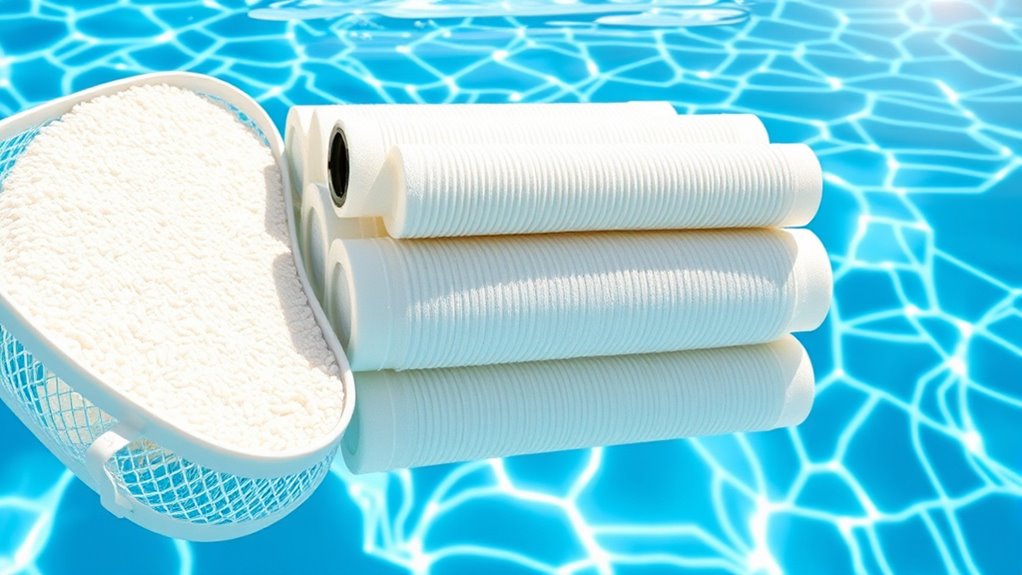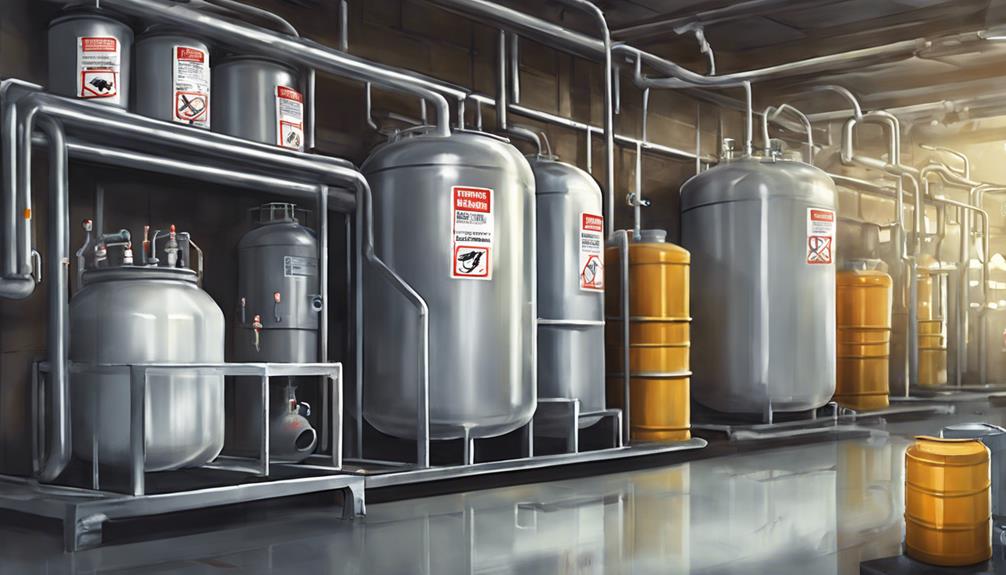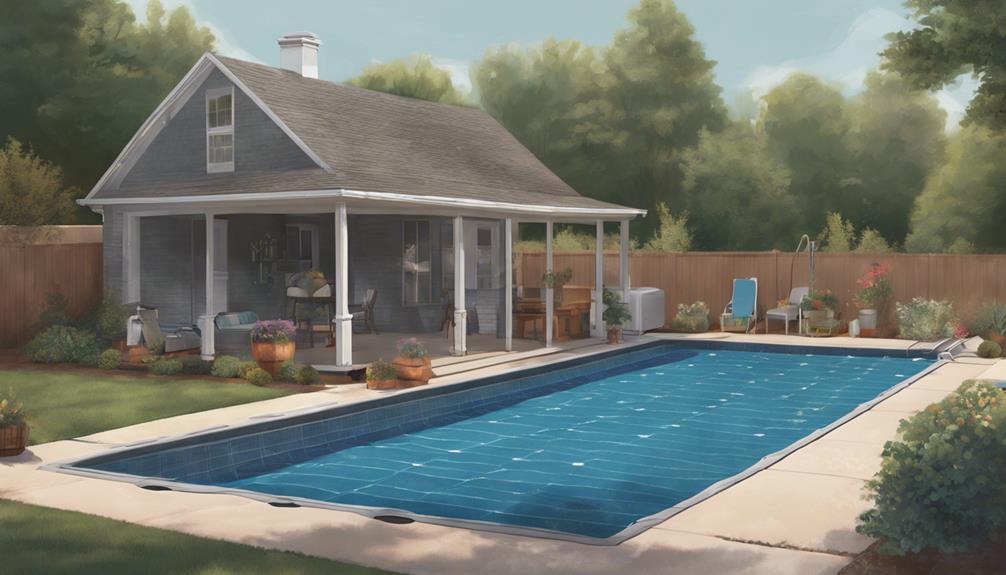Choosing between sand, cartridge, and DE filters depends on your pool needs. Sand filters are simple and low-maintenance but less effective for fine particles. Cartridge filters capture smaller debris and are easy to clean, while DE filters offer the highest level of filtration, trapping microscopic dirt for crystal-clear water. Each type requires specific upkeep and water chemistry balance. To find out which fits your pool best and how to keep them running smoothly, keep exploring for detailed tips.
Key Takeaways
- Sand filters are easy to maintain, suitable for coarse debris, and require backwashing every few weeks.
- Cartridge filters capture finer particles, are simple to clean by rinsing, and are ideal for clearer water.
- DE filters provide the highest filtration level, trapping microscopic particles, but need more maintenance and precise water chemistry.
- Proper water chemistry balance extends filter lifespan and ensures optimal performance across all filter types.
- Regular maintenance, including backwashing or media replacement, is essential for effective pool filtration and water quality.

Maintaining a clean and healthy pool requires a solid understanding of filtration systems, which work continuously to remove debris, dirt, and contaminants from the water. These systems are essential to keeping your pool water clear and safe, but choosing the right type depends on various factors, including water chemistry and maintenance schedules. Each filter type—sand, cartridge, and DE—has unique advantages and considerations, and understanding how they operate helps you select the best option for your pool.
Sand filters are the most common and generally the easiest to maintain. They use a bed of specially graded sand to trap particles as water passes through. Over time, the sand can become clogged with dirt and debris, reducing efficiency. You’ll need to backwash the filter regularly—typically every few weeks—to flush out accumulated debris. Sand filters are effective for filtering larger particles but may struggle with finer contaminants, so you might need to clean or replace the sand every 5 to 7 years. When it comes to water chemistry, maintaining proper pH and sanitizer levels is vital. Imbalanced water can cause cloudiness or scaling, which can clog the sand bed and shorten its lifespan. Regular testing and adjustments as part of your maintenance schedule keep the filter working at its best.
Sand filters are easy to maintain but require regular backwashing and sand replacement every 5-7 years.
Cartridge filters use a pleated paper or fabric element to trap dirt and debris. They’re generally easier to maintain than sand filters because you can simply remove and rinse the cartridge with a garden hose. Depending on pool usage and water quality, you might need to clean the cartridge every few weeks or monthly. Cartridge filters are excellent for capturing finer particles, which means they often produce clearer water. They don’t require backwashing, which saves water and reduces wear and tear. Because they are more sensitive to water chemistry changes, maintaining balanced water chemistry is especially important here. If your water’s pH drifts out of ideal range, it can lead to clogging or mold growth on the cartridge, decreasing filtration efficiency.
Diatomaceous Earth (DE) filters deliver the highest level of filtration, capturing even microscopic particles. They use a layer of DE powder coated onto grids inside the filter for superior filtration. DE filters typically need to be cleaned and recharged with fresh DE powder every few months, depending on usage. They require more maintenance and a more precise maintenance schedule but offer the best water clarity. To keep these filters functioning properly, you must monitor water chemistry carefully. Imbalances in pH or sanitizer levels can cause DE to become sticky or clog the system faster. Properly maintaining water chemistry ensures your DE filter performs at peak efficiency, providing crystal-clear water.
Understanding these differences helps you establish appropriate maintenance schedules for your pool’s filtration system. Regularly testing and adjusting water chemistry, along with routine filter maintenance, ensures your pool stays clean and inviting all season long.
Frequently Asked Questions
Which Pool Filter Type Is Most Energy-Efficient?
You’ll find that cartridge filters are the most energy-efficient option for your pool. They consume less power because they require less water pressure to operate, which reduces energy consumption. Their filter efficiency is high, capturing dirt and debris effectively without needing frequent backwashing or cleaning. Choosing a cartridge filter can save you money on electricity bills while maintaining clear, clean water with minimal effort.
How Often Should I Replace Filter Media?
Did you know that proper filter media maintenance can extend your pool’s clarity and efficiency? You should replace your filter media every 3 to 5 years for sand, 1 to 2 years for cartridge, and annually for DE filters. The lifespan depends on usage and water quality. Regularly inspecting your filter helps identify when replacement is needed, ensuring peak performance and clean water throughout the swimming season.
Can I Switch Filter Types Without Draining the Pool?
Yes, you can switch filter types without draining your pool, but it’s not always ideal. You’ll need to perform proper filter maintenance during the switch, including cleaning and removing debris. Just guarantee the new filter is compatible with your system. Keep in mind that changing the filter type may require some adjustments and extra care to maintain ideal filtration and avoid unnecessary filter replacement.
What Is the Ideal Filter Pressure Range?
You should keep your filter pressure between 8 and 12 psi above the clean filter pressure to guarantee ideal performance. Regularly check your filter pressure to catch any issues early. Incorporate this into your maintenance schedule by inspecting the pressure gauge weekly and cleaning or backwashing your filter as needed. Maintaining proper filter pressure helps keep your pool clean and extends the lifespan of your filtration system.
Are There Eco-Friendly Filtration Options Available?
Imagine a cleaner, greener pool—yes, it’s possible! You can choose eco-friendly alternatives like biodegradable filters that break down naturally, reducing environmental impact. These options use sustainable materials and often require less energy, making your pool maintenance more eco-conscious. By switching to biodegradable filters, you not only keep your pool sparkling but also contribute to a healthier planet. Isn’t it time your pool’s filtration matched your eco-friendly values?
Conclusion
Choosing the right pool filter might seem overwhelming, but understanding the basics helps you make an informed decision. Sand, cartridge, and DE filters each have pros and cons, so pick one that fits your pool size and maintenance preferences. Some worry about ongoing costs, but regular upkeep keeps your filter running efficiently and saves you money in the long run. With a little knowledge, you’ll enjoy crystal-clear water all season without hassle.










